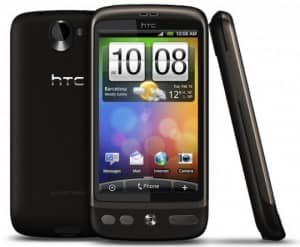Overview:
Here at Gaj-IT, we often talk about phones living up to their names, and being called Desire gives HTC's latest Android release a lot to live up to. So does this big brother of the Google Nexus One get us hot under the collar? Let's find out.
Preview:
We took a quick look at the HTC Desire when it was launched at this year's MWC, and first impressions were good.
HTC has a track record for consistently doing well in other mobile phone reviews, so we're feeling pretty good about the Desire already.
The phone is basically the latest version of the Nexus One, with a few more features under a sleek bronze exterior.
What you notice first with this handset is the large 3.7 inch screen, which makes you want to just sit there and watch videos for awhile. This is enhanced by AMOLED technology over ye olde TFT, resulting in a brighter picture with bolder colours.
The Desire does a good job in feeling desirable with its curved edges and thin 11.9mm body. Coming in a bronze-toned colour, it also makes for something different to the ton of black plastic on the market today.
Under the bonnet, you will see similar specs to the Nexus One with 512MB flash memory, 576MB of RAM and a microSD slot so you can attempt to store at least half of your music collection onto the phone.
The phone comes with Wi-Fi, Bluetooth, HSDPA, GPA and A-GPS connectivity, so you're not short of options for reaching the outside world.
The 1GHz Qualcomm Snapdragon processor also brings the Desire in line with the Nexus One.
So where do the differences come in? The main disparity is the HTC Sense UI on the Desire, which has gone through some tweaks and is faster and integrates a bit more logically with the phone's other features.
HTC's Sense gives you seven home pages, which is two more than you get on the Nexus One. If you're a fan of your widgets, the extra access to photos, your calendar or quirky game on your home screen won't go unappreciated.
Thanks to the multi-touch enabled screen, you can do some pretty nifty things with Sense, such as using two fingers to pinch whichever home screen you're on to go into Leap thumbnail view, which let's you see all of your home screens at once.
Another difference is the Desire's use of a navigational trackpad over a trackball, which does makes for a less tactile feel when scrolling through menus, but will increase the longevity of the phone as trackballs have been known to fail over time which isn't good when you're on a 2 year contract.
A 5 megapixel camera with LED flash on the back of the phone keeps the Desire in line with today's mainstream camera specs on the market. It also features autofocus and digital zoom.
With a number of HTC Desire deals out there, this phone makes getting your hands on an Android handset accessible.
Overall the Desire has a great balance of things you'd want in a smartphone, and once you feel one in the palm of your hand, you may never want to put it down.
The Gaj-It Verdict:
Design: 9/10
Usability: 8/10
Features: 7/10
Value: 8/10
We Say:
We love the big, bold screen on the Desire and think this is the handset to get people really longing for an Android phone. It may not have the flashest specs on the high street, but it ticks all the boxes and with the HTC Sense UI, brings something of its own to the phone world.


2 thoughts on “Preview: HTC Desire. Does it Make You Long for an Android?”
Purchased my HTC Desire 2 nights ago and love it. Its everything i expected from all the reviews and videos I’ve seen. Bought the phone through Telstra who have exclusive rights to it for the first few months.
One thing that annoys me about that is that the phone appears to have their branding on it. Totally annoys the hell out of me. Want to remove it but I would most likely have to flash it Sad. Came across http://www.HTCDesireForum.com not sure how good it is, but worth a look.